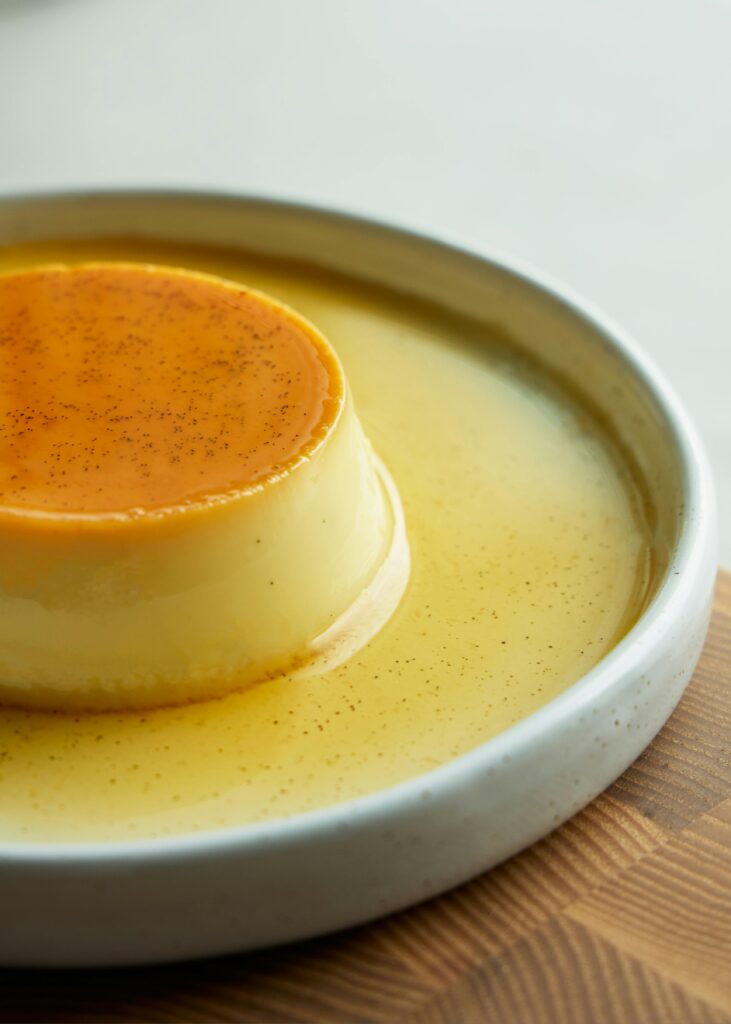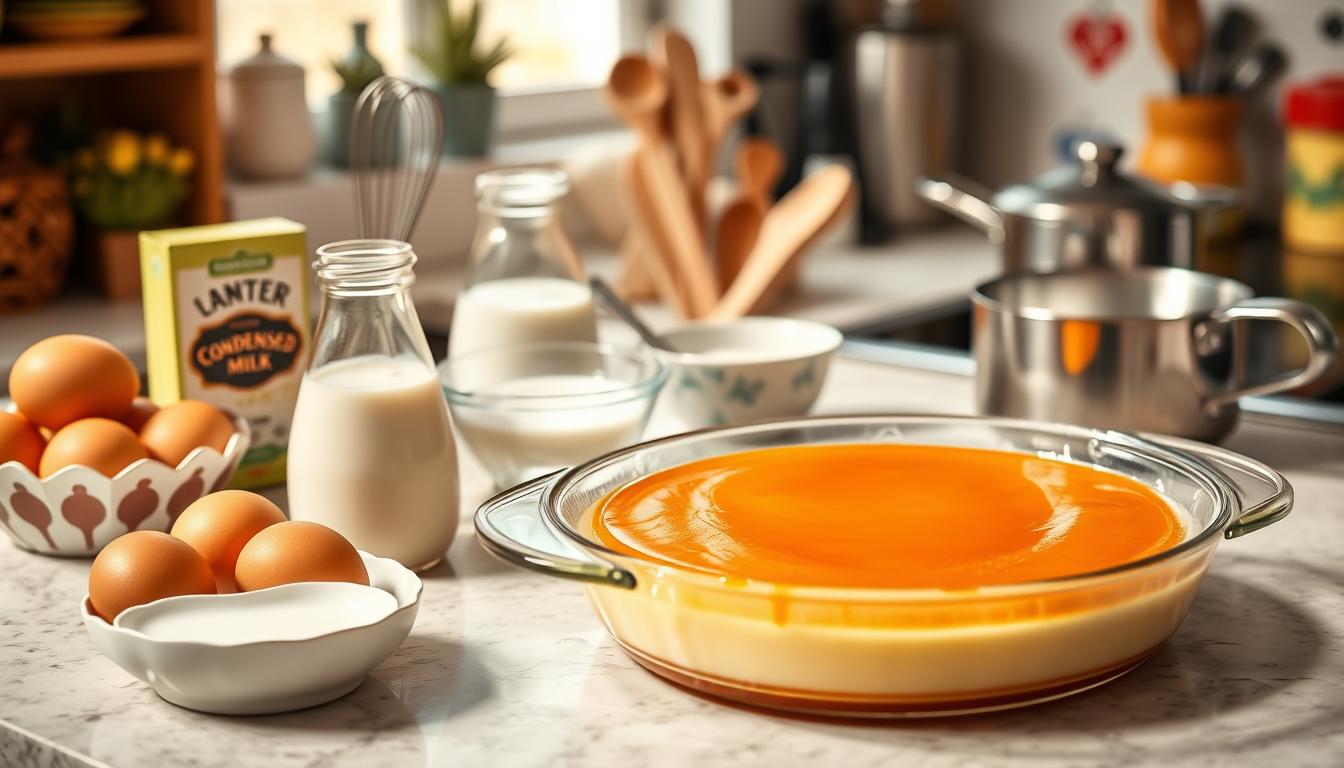Imagine sinking your spoon into a silky smooth, creamy dessert. It feels like you’re in the vibrant streets of Venezuela. A flan-like treat, has been loved by Venezuelans for generations. It reminds me of my grandmother’s quesillo, a recipe filled with love and care.
Today, I’m excited to share this easy quesillo recipe with you. You can make the traditional flavors of Venezuela in your own kitchen. This recipe is perfect for impressing your loved ones and bringing a taste of South America to your home.
Table of Contents
Introduction to Venezuelan Quesillo: A Beloved Dessert Tradition
Quesillo is a traditional Venezuelan dessert loved by many. It’s creamy and custard-like, making it a favorite at family events. It’s a big part of Venezuela’s rich food culture.
Quesillo comes from traditional Mexican cuisine, like flan. But it has its own special taste and texture. This makes it a unique treat in the world of sweets.
The flavors and textures of quesillo are what make it special. It has a smooth custard with vanilla and condensed milk sweetness. The caramelized top adds a nice crunch.
“Quesillo is more than just a dessert; it’s a cultural institution in Venezuela, woven into the fabric of family gatherings and celebrations.”
Quesillo is also very important in Venezuelan culture. It’s a symbol of pride and tradition. Families share recipes and make memories while enjoying it.
Exploring quesillo opens up a world of flavors. It’s not just a dessert but a window into Venezuelan culture. Enjoy it and taste the heart of South America.
Essential Ingredients for Perfect Quesillo Recipe
Making a true Venezuelan quesillo, a custard-like dessert, needs the right ingredients. Choosing the best milk and sweetener is key. Each part is crucial for the perfect texture and taste of this traditional treat.
Choosing the Right Type of Milk
The base of quesillo is the milk. Whole milk is traditional, but you can try other types for different textures. Whole milk makes it creamy, while low-fat or skimmed milk makes it lighter. Mixing whole milk with heavy cream can make it even creamier.
Understanding Different Sweeteners
The sweetness of quesillo comes from the sweetener. Granulated sugar is common, but panela (unrefined cane sugar) or honey can add a special touch. Adjust the sugar to your taste, remembering the caramel topping adds sweetness too.
Quality of Eggs and Other Components
- Eggs: Fresh, high-quality eggs are essential for a silky, custard-like texture. Use large eggs and ensure they are at room temperature before incorporating them into the batter.
- Vanilla: A touch of pure vanilla extract enhances the depth of flavor in quesillo, complementing the sweetness and creaminess.
- Salt: A pinch of salt helps to balance the sweetness and bring out the other flavors in the dessert.
Choosing the right milk, sweetener, and other ingredients makes a quesillo that captures Venezuela’s artisanal cheesemaking and culinary traditions.
| Ingredient | Quantity | Purpose |
|---|---|---|
| Whole Milk | 4 cups | Provides a rich, creamy base |
| Granulated Sugar | 3/4 cup | Sweetens the custard |
| Large Eggs | 6 | Contributes to the silky, custard-like texture |
| Vanilla Extract | 1 teaspoon | Enhances the overall flavor |
| Salt | 1/4 teaspoon | Balances the sweetness |
Kitchen Tools and Equipment You’ll Need
To make the perfect quesillo, you need some key kitchen tools. The right tools make preparation easier and more fun.
You’ll first need a strong, oven-safe baking dish or ramekins. These are where your custard dessert will go. A saucepan is also important for mixing the ingredients on the stovetop.
- A whisk is key for mixing the custard well, making it smooth.
- A fine-mesh strainer or colander helps get rid of lumps or impurities in the custard.
- A kitchen torch is great for caramelizing the top, adding a nice crème brûlée touch.
Using a stand mixer or hand mixer can make mixing easier. This is especially helpful when making a lot of quesillo.
| Tool | Purpose | Alternative |
|---|---|---|
| Baking Dish or Ramekins | Containers for the custard | Oven-safe casserole dish or individual ramekins |
| Saucepan | Heating and mixing the ingredients | Medium-sized pot or skillet |
| Whisk | Blending and aerating the custard | Fork or handheld mixer |
| Strainer or Colander | Removing lumps and impurities | Fine-mesh sieve |
| Kitchen Torch | Caramelizing the top | Broiler or a small kitchen lighter |
With these quesillo preparation tools, you’re ready to make a delicious Venezuelan flan at home.
Step-by-Step Preparation Method
Making the perfect quesillo is all about detail. From making the caramel base to mixing the custard, each step is crucial. Follow these steps to master quesillo production and quesillo preparation methods.
Preparing the Caramel Base
Start with the caramel base, the heart of your quesillo. Heat sugar in a saucepan over medium heat, stirring constantly. Watch it turn golden brown, but be careful not to burn it. Pour the caramel into a baking dish, covering the sides evenly. Let it cool and harden.
Mixing the Custard
Now, mix the custard. Whisk eggs, condensed milk, and evaporated milk in a large bowl. Add vanilla extract for extra flavor. Pour the custard over the cooled caramel base, spreading it evenly.
Proper Baking Techniques
- Preheat your oven to 350°F (175°C).
- Place the baking dish in a larger pan filled with hot water, creating a water bath, or bain-marie.
- Bake the quesillo for 45-60 minutes, or until the center is set and a knife inserted comes out clean.
- Allow the quesillo to cool completely before refrigerating for at least 2 hours, or until chilled through.
By following these steps, you’ll make a delicious quesillo. It will be a true Venezuelan dessert.
Tips for Achieving the Perfect Texture
Making a delicious quesillo, the traditional Venezuelan flan, is all about getting the texture right. Whether you’re a pro in the kitchen or new to artisanal cheesemaking, these tips will guide you. They’ll help you make a quesillo that’s smooth and creamy, sure to wow your guests.
- Focus on the Caramel-to-Custard Ratio: Getting the caramel and custard just right is key. Make sure to measure your ingredients carefully. This will help you find the perfect mix that’s smooth and flavorful.
- Be Gentle When Adding Eggs: Beating the eggs too much can make the quesillo grainy. Mix them into the custard gently. This ensures everything is well combined without becoming too thick.
- Bake with Care: The right baking temperature and time are crucial. Stick to the recipe and use an oven thermometer. This prevents the quesillo from becoming too dense or dry.
By following these tips, you’ll be on your way to making a quesillo recipe that’s smooth and creamy. Enjoy the rich taste of this Venezuelan dessert. Impress your friends with your skill in artisanal cheesemaking.
| Texture Tip | Explanation | Desired Outcome |
|---|---|---|
| Caramel-to-Custard Ratio | Finding the perfect balance between the caramel base and the custard filling | Harmonious blend of flavors and silky-smooth consistency |
| Gentle Egg Incorporation | Folding the eggs into the custard mixture without overbeating | Creamy, smooth texture without graininess or curdling |
| Precise Baking Techniques | Maintaining the correct temperature and baking time | Achieving the desired dense, yet creamy texture |
“The secret to a sublime quesillo lies in the careful balance of its components and the artful execution of the baking process.”
Common Mistakes to Avoid When Making Quesillo
Making the perfect Venezuelan-style quesillo is a fun cooking journey. Even skilled cooks can run into a few common problems. Knowing these issues helps make sure your quesillo is perfect every time.
Temperature Control Issues
Getting the temperature right is key for a creamy and caramelized quesillo. If it’s overcooked, it can be rubbery or grainy. If it’s undercooked, it’s watery. Watch the oven temperature and baking time closely to avoid these issues.
Caramel Problems
The caramel base is vital for quesillo’s rich flavor and golden color. But caramel can be hard to get right. Burned caramel or uneven coating can make it bitter or look bad. Focus on caramelizing it well and making sure it coats the dish evenly.
Baking Time Errors
Finding the right baking time for quesillo is tricky. Too long and it’s dry and rubbery. Too short and it’s wet and not done. Keep an eye on it while it bakes. Use a toothpick or knife to check if it’s set before taking it out of the oven.
By watching out for these common mistakes, you can improve your quesillo making. With practice and attention to detail, you’ll soon be making this traditional dessert like a pro.

Storage and Serving Suggestions
Keeping the flavors and textures of the quesillo recipe just right is key. This dessert is a favorite in Mexican cuisine. Proper storage and serving can enhance your enjoyment of this creamy treat.
Storing Quesillo Properly
To keep the quesillo smooth and moist, follow these tips:
- Refrigerate it in an airtight container for up to 4 days.
- Don’t let it sit at room temperature for too long. It can dry out.
- Reheat it gently in a water bath or microwave. Be careful not to overheat.
Serving Quesillo with Flair
Quesillo tastes best chilled or at room temperature. Here are some ways to make it even more special:
- Add a sprinkle of cinnamon or caramel sauce for a classic look.
- Top it with fresh berries or toasted coconut flakes for a pop of color.
- Pair it with vanilla ice cream or whipped cream for a rich treat.
By storing and serving quesillo the right way, you can enjoy its true taste. It brings a piece of Mexican cuisine to your home.
Regional Variations and Modern Twists
The Venezuelan quesillo, a favorite dessert, has spread across Latin America. It keeps its core recipe but has many regional and modern twists. This has made a colorful mix of Mexican cheese recipes and Oaxacan cheese dishes.
Traditional vs Contemporary Methods
In Venezuela, the quesillo is a soft flan with a caramelized top. In Mexico, it’s firmer, like cheese, with local touches like queso fresco and queso Oaxaca.
Today’s chefs add exciting flavors to quesillo. They mix in tropical fruits, nuts, and spices. This creates new, tasty versions that push the dessert’s limits.
Popular Flavor Adaptations
- Guava Quesillo: A colorful twist with sweet guava compote.
- Spiced Chocolate Quesillo: Rich and spicy, with cinnamon and chili.
- Coconut Quesillo: Sweet coconut adds a tropical flavor.
Whether you love the old recipe or the new twists, quesillo’s appeal is strong. It’s a favorite among dessert lovers in the Americas.
| Traditional Quesillo | Contemporary Quesillo |
|---|---|
| Custard-like texture | Firmer, cheese-like consistency |
| Caramelized glaze topping | Infused with bold, innovative flavors |
| Classic Venezuelan recipe | Regional interpretations across Latin America |
Conclusion
In this article, you’ve explored the world of Venezuelan quesillo. This traditional dessert is loved by many across the region. You now know how to make this flan-like treat at home.
Learning about the right ingredients and how to prepare them is key. You can make quesillo with the authentic taste and texture. With the right tools and techniques, you’re ready to make this Venezuelan dish.
Start making quesillo and follow expert tips for the best results. You can stick to the classic recipe or try new flavors. This dessert lets you experience Venezuelan culinary heritage. So, get your ingredients ready and enjoy the aroma of homemade quesillo.
FAQ
What is quesillo, and how is it different from other Latin American desserts?
Quesillo is a favorite Venezuelan dessert, like flan or crème caramel. It has a creamy texture and a sweet caramel topping. It’s unique because of its flavor and how it’s made, different from other custard desserts.
What are the essential ingredients for making the perfect quesillo?
To make great quesillo, you need top-quality milk, eggs, sugar, and vanilla. The kind of milk and the quality of eggs and sugar affect its taste and texture.
What kitchen tools and equipment are needed to make quesillo?
You’ll need a baking dish, a saucepan, a whisk, and basic kitchen tools. The baking dish is for the caramel and custard. The saucepan and whisk are for mixing and cooking the custard.
What is the step-by-step process for preparing quesillo?
Making quesillo starts with a caramel base, then mixing the custard. Finally, baking the dessert is key. Each step is crucial for the right texture and taste.
How can I achieve the ideal texture for my quesillo?
For the perfect quesillo, focus on temperature, caramel consistency, and baking time. Expert tips and avoiding mistakes will help you get a smooth, creamy dessert.
What are some common mistakes to avoid when making quesillo?
Common mistakes include temperature and caramel issues, and wrong baking times. Knowing how to manage these can prevent texture and flavor problems.
How should I store and serve quesillo?
Store quesillo in the fridge for a few days. Serve it cold. Try adding fresh fruit or caramel sauce for extra flavor.
Are there any regional variations or modern twists on the traditional quesillo recipe?
Yes, quesillo has traditional and modern versions in Venezuela and Latin America. While the basic recipe stays the same, different regions and chefs add their own twists.

